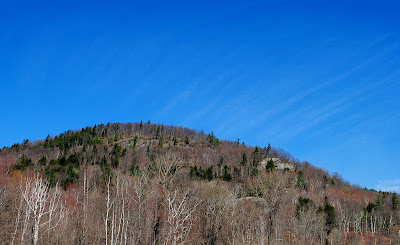The following post will serve as an outline summary of the National Wildlife Federation's Critical Paths: Enhancing Road Permeability For Wildlife In Vermont. This report from August 2009 is one of the more valuable local resources regarding habitat connectivity, although it does not specifically analyze Interstate 89. In the context of our project's first goal to determine: 1) the effects of Interstate-89 as a barrier on wildlife habitat and movement patterns along the three mile border between Bolton and Duxbury and 2). what can be done to promote safe and efficient highway travel while maintaining ecological integrity and continuity of the Green Mountain habitat/corridor.
The Large Picture:
According to the report, in 2008, Vermont had 14,122 miles of public roadways. Interstate 89 holds claim to around 130 miles of that number. It doesn't seem like a lot. In fact, it's less than 0.01% of the total roadway in the state. But even the smallest number can have some of the most serious implications. With four continuous lanes and a path of travel that takes the highway through the Green Mountain corridor, I-89 falls short of only Interstate 91 which maneuvers north to south through the Connecticut River Valley regarding length x lanes.
The National Wildlife Federation has designated 124 crossing zones of the Green Mountain corridor in this report, eliminates 80 (because they run north to south and do not serve as an "intersection" so to speak), and does not include six of these zones which fall within Interstate 89. The report claims: "This is the single greatest fragmenting feature to north-south habitat connectivity in Vermont and potential solutions to this area will likely be complicated and expensive."
It is clear that we're up against some heavy challenges.
Concerning the Site:
The report also outlines the criteria used to evaluate crossing zones. GIS mapping is required in this stage of analysis and while the NWF does not include the I-89 site, another project developed by the state in cooperation with VTrans does (this project will be included in another post as a whole in the near future).
The criteria are as follows (listed from higher to lower importance):
Habitat Sustainability - Based off of housing density & core habitat, Rating 6-10 - Our site, according to the analysis from 2006, ranges close to zero (nearest the town of Bolton), up to values of 7.5-8 directly on the highway.
Conserved Lands - As previously mentioned, Mount Mansfield State Forest borders are under 3 miles to the northwest of the site and Camel's Hump State Park borders are within 0.5 miles to the south.
Wildlife Crossing Value - based off mortality rates, 5-10 - This value also varies along our site range. Where habitat ratings were low, mortality rates are highest in moose and bear. The lower the number, the more historically dangerous the crossing is, and surrounding Bolton, the values range from 5.5-6 for nearly a mile. Higher values of 9 occur towards the east end of the site, most likely due to the higher cliff surroundings that do not place wildlife at road level.
Road Kill - In the areas where crossing values are <6, 62.2% of all bear collisions and 70.1% of all moose collisions occur statewide. There are several recorded moralities of moose and bear mainly concentrated to the far west and east of our site range.
Effects of Interstate 89
Seasonal migration - The black bear, mentioned earlier as one of the more prominent subjects of this study, has high populations concentrated in Mount Mansfield State Forest. Management plans for this mammal in the protected areas to the north can be found here (another publication that will be considered in later posts). The black bear relies on seasonal habitat, and can be restricted in movement by highways such as I-89. The masting of beech stands in the summer and fall and den habitats for the winter require movement of the black bear that (as we have seen) can lead to high mortality rates.
Genetic Flow - One of the sole purposes of biological conservation is maintaining genetic variation and gene flow in order to minimize local extirpation. By reducing movement and limiting populations to certain areas of their habitat (regardless of high habitat sustainability values), humans run the risk of restricting necessary heritability and losing populations of species that do not exist in high numbers in the first place.
Road Mortality - As mentioned earlier, road mortality rates are high in certain sections of our site range. The report cites a study done in 1998 that concluded collisions in the United States surpassed hunting as the leading cause of direct vertebrate mortality (one million per daily). Moose and bear make up the most of these collisions and only exist in Vermont at levels just below or around 5,000 each.
What Can Be Done?
We have already covered the most clear and known options of overpasses and underpasses, but there are some other steps outlined by the report that gradually work up to large scale construction through influence of policy and the public directly.
-Seek to conserve lands surrounding site to whatever degree possible, whether public through the state or private working with a landowner. Incorporate buffers of conserved land surrounding area.
-Seek to implement conservation strategy or plans in town policies (Bolton/Duxbury)
-Incorporate wildlife corridor protection into zoning regulations.
-Seek to link corridor protection with backing support of residents, tourists, and anyone who has a say economically.
-Control speed limits to a different degree
-Seek to reduce development in the surrounding area.
These are just a few small steps that will help lead to a greater solution. Each gradual move forward is important in what is clearly defined as a large problem for the State of Vermont.















